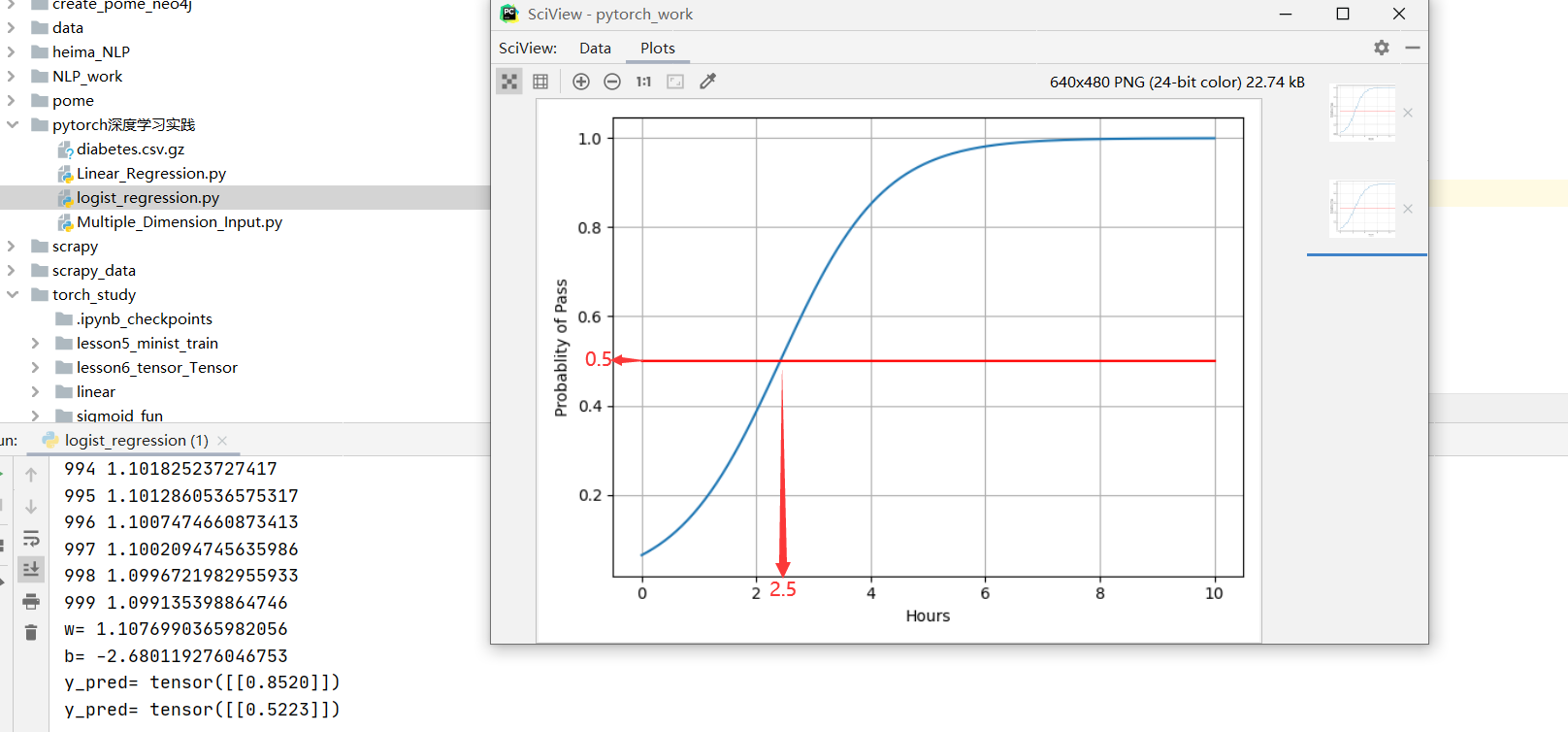pytorch实现单维度线性回归
代码
import torch
x_data=torch.Tensor([[1.0],[2.0],[3.0]])
y_data=torch.Tensor([[2.0],[4.0],[6.0]])
class LinearModel(torch.nn.Module):
def __init__(self):
super(LinearModel,self).__init__()
self.linear=torch.nn.Linear(1,1)
def forward(self,x):
y_pred=self.linear(x)
return y_pred
model=LinearModel()
criterion=torch.nn.MSELoss(size_average=False)
optimizer=torch.optim.SGD(model.parameters(),lr=0.01)
for epoch in range(1000):
y_pred=model(x_data)
loss=criterion(y_pred,y_data)
print(epoch,loss.item())
optimizer.zero_grad()
loss.backward()
optimizer.step()
print('w=',model.linear.weight.item())
print('b=',model.linear.bias.item())
x_test=torch.Tensor([[4.0]])
y_test=model(x_test)
print('y_pred=',y_test.data)
结果

logist逻辑回归分类
代码
import torch
import torch.nn.functional as F
x_data=torch.Tensor([[1.0],[2.0],[3.0]])
y_data=torch.Tensor([[0],[0],[1]])
class LogisticRegressionModel(torch.nn.Module):
def __init__(self):
super(LogisticRegressionModel,self).__init__()
self.linear=torch.nn.Linear(1,1)
def forward(self,x):
y_pred=torch.sigmoid(self.linear(x))
return y_pred
model=LogisticRegressionModel()
criterion=torch.nn.BCELoss(reduction='sum')
optimizer=torch.optim.SGD(model.parameters(),lr=0.01)
for epoch in range(1000):
y_pred=model(x_data)
loss=criterion(y_pred,y_data)
print(epoch,loss.item())
optimizer.zero_grad()
loss.backward()
optimizer.step()
print('w=',model.linear.weight.item())
print('b=',model.linear.bias.item())
x_test=torch.Tensor([[4.0]])
y_test=model(x_test)
print('y_pred=',y_test.data)
x_test=torch.Tensor([[2.5]])
y_test=model(x_test)
print('y_pred=',y_test.data)
import numpy as np
import matplotlib.pyplot as plt
x=np.linspace(0,10,200)
x_t=torch.Tensor(x).view((200,1))
y_t=model(x_t)
y=y_t.data.numpy()
plt.plot(x,y)
plt.plot([0,10],[0.5,0.5],c='r')
plt.xlabel('Hours')
plt.ylabel('Probablity of Pass')
plt.grid()
plt.show()
结果

多维度输入分类
代码
import torch
import numpy as np
xy=np.loadtxt('diabetes.csv.gz',delimiter=',',dtype=np.float32)
x_data=torch.from_numpy(xy[:,:-1])
y_data=torch.from_numpy(xy[:,[-1]])
class Model(torch.nn.Module):
def __init__(self):
super(Model,self).__init__()
self.linear1=torch.nn.Linear(8,6)
self.linear2 = torch.nn.Linear(6,4)
self.linear3 = torch.nn.Linear(4,1)
self.sigmoid=torch.nn.Sigmoid()
self.activate=torch.nn.ReLU()
def forward(self,x):
x=self.sigmoid(self.linear1(x))
x = self.sigmoid(self.linear2(x))
x = self.sigmoid(self.linear3(x))
return x
model=Model()
criterion=torch.nn.BCELoss(reduction='sum')
optimizer=torch.optim.SGD(model.parameters(),lr=0.01)
for epoch in range(100):
#forward
y_pred=model(x_data)
loss=criterion(y_pred,y_data)
print(epoch,loss.item())
#backward
optimizer.zero_grad()
loss.backward()
#update
optimizer.step()
结果

总结
pytorch相对于tensorflow来说代码更加方便,而且模块化的效果很好,继续学习,另外力推B站pytorch视频:https://www.bilibili.com/video/BV1Y7411d7Ys?p=8&spm_id_from=pageDriver